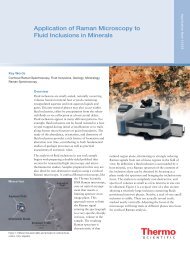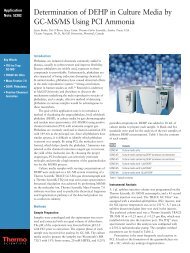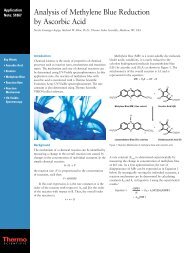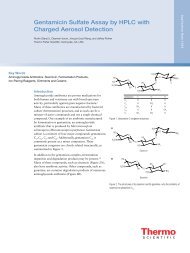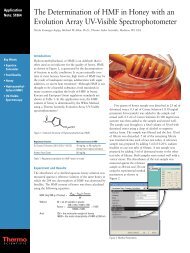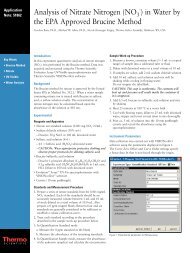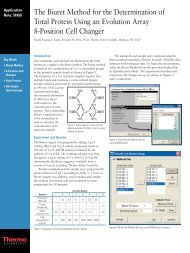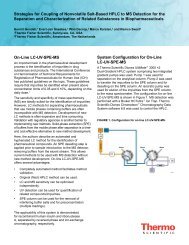Analysis of Residual Solvents using GC/FID with Headspace and a ...
Analysis of Residual Solvents using GC/FID with Headspace and a ...
Analysis of Residual Solvents using GC/FID with Headspace and a ...
You also want an ePaper? Increase the reach of your titles
YUMPU automatically turns print PDFs into web optimized ePapers that Google loves.
Application Note:ANCCSRESSOLV1010<strong>Analysis</strong> <strong>of</strong> <strong>Residual</strong> <strong>Solvents</strong> <strong>using</strong> <strong>GC</strong>/<strong>FID</strong><strong>with</strong> <strong>Headspace</strong> <strong>and</strong> a CyanopropylphenylPolysiloxane PhaseA. Khan, L. Pereira, Thermo Fisher Scientific, Runcorn, Cheshire, UKKey Words• TRACE TR-V1Column• <strong>Residual</strong> <strong>Solvents</strong>in PharmaceuticalProducts• USP 467 methodOverviewA Thermo Scientific TRACE Ultra <strong>GC</strong> system <strong>with</strong> aThermo Scientific TriPlus Autosampler was used for theanalysis <strong>of</strong> residual solvents in accordance <strong>with</strong> USPmethod 467. 1 The column used for the analysis was aThermo Scientific TRACE TR-V1 column.IntroductionThis application note describes the analysis <strong>of</strong> residualsolvents according to the revised (effective July 2007) USPharmacopeia (USP) method. The method is used foranalyzing trace levels <strong>of</strong> solvents that are involved in theproduction <strong>of</strong> a drug, excipient or product packaging in thepharmaceutical industry. Drug products should contain lowlevels <strong>of</strong> residual solvents as determined by safety data.The USP 467 method involves the analysis <strong>of</strong> 53solvents grouped according to their genotoxic hazards:• Class 1 solvents (known to cause unacceptable toxicities)should be avoided in the manufacturing process.• Class 2 solvents (associated <strong>with</strong> less severe toxicity)should be limited.• Class 3 solvents (less toxic) should be used where practical.Three analytical procedures are used for identification<strong>and</strong> quantification <strong>of</strong> the residual solvents:• Procedure A is used for screening <strong>and</strong> confirmation <strong>of</strong>the solvents identity <strong>and</strong> use a G43 (volatiles) column.• Procedure B is used for confirmation <strong>of</strong> the solventsidentity <strong>using</strong> a G16 (wax) column.• Procedure C, which uses a G43 column, is required toquantify the amount <strong>of</strong> residual solvents.MethodsSamplesUSP 467 test mixtures solutions prepared according to USP 467 methodColumnTRACE TR-V1 30 m × 0.32 mm × 1.8 µmPart Number260V339P<strong>GC</strong>/<strong>FID</strong> ConditionsTriPlus <strong>Headspace</strong> AutosamplerSample VolumeSample <strong>Analysis</strong> Time1 mL30 minAgitator Temperature 80 °CIncubation TimeAgitator Shake45 minSyringe Temperature 100 °CPost Injection FlushTRACE <strong>GC</strong> UltraOven ProgramEquilibration TimeOn 10 s, Off 20 s30 s40 °C (20 min), 10 °C/min, 240 °C (10 min)0.5 min.Injector 140 °CSplit FlowColumn Flow40 mL/min2.0 mL/min (constant)Detector <strong>FID</strong> at 240 °CDetector Air FlowDetector H 2 FlowDetector N 2 Makeup FlowConsumables350 mL/min35 mL/min30 mL/minPart NumberTR-Green septa313G3211Thermo Scientific Split FocusLiner for 50 mm needle<strong>with</strong> Quartz Wool453T1905Liner graphite seal 29033406Graphite ferrule for 0.32 mm ID column 290134872.5 mL headspace syringe 3650300620 mL clear crimp top vial 60180-506Aluminum 20 mm cap <strong>and</strong> Si/PTFE seal 60180-511
Measured SpecifiedPeak # Peak Identification Rt (min) S/N S/N1 1,1-Dichloroethane 4.06 108 > 32 1,1,1-Trichloroethane 9.90 186 > 53 Carbon Tetrachloride 10.53 15 > 34 Benzene 11.43 351 > 35 1,2-Dichloroethane 11.87 213 > 3Figure 1: <strong>GC</strong>/<strong>FID</strong> chromatogram for class 1 residual solventsResults <strong>and</strong> DiscussionThe acceptance criteria for USP 467,class 1 solvents, is that the signal-tonoiseratio for 1,1,1-Trichloroethane(peak 2) is greater than 5 <strong>and</strong> that thesignal-to-noise ratio obtained fromthe other compounds in the class isgreater than 3. The chromatogram<strong>and</strong> signal to noise measurementsobtained <strong>using</strong> the method describedpreviously are shown in Figure 1.The USP 467 method specificationfor class 2 solvents is that theresolution between acetonitrile <strong>and</strong>dichloromethane (peaks 2 <strong>and</strong> 3) isnot less than 1.0. The chromatogramsobtained for class 2 solvents (mixtureA <strong>and</strong> mixture B) are shown inFigures 2 <strong>and</strong> 3. The method criteriafor resolution between the criticalpair is met as these are fully resolved.All the other components are als<strong>of</strong>ully resolved, which demonstratesgood selectivity <strong>and</strong> efficiency <strong>of</strong> thechromatographic separation takingplace in the TRACE TR-V1 column.Poor response was observed for1,4-Dioxane, which was expected.Peak # Peak Identification Rt (min)1 Methanol 2.582 Acetonitrile 4.713 Dichloromethane 5.004 Trans-1,2-Dichloroethane 5.535 Cis-1,2-Dichloroethane 8.256 Tetrahydr<strong>of</strong>uran 9.167 Cyclohexane 9.948 Methylcyclohexane 15.979 1,4-Dioxane 18.3510 Toluene 23.3311 Chlorobenzene 27.1712 Ethyl Benzene 27.3913 m-Xylene/p-Xylene 27.6414 o-Xylene 28.42Figure 2: <strong>GC</strong>/<strong>FID</strong> chromatogram for class 2A residual solvents



